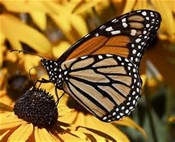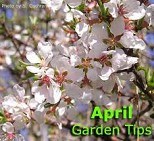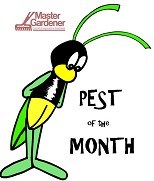It's easy to lure butterflies to your yard by planting a few of their favorite flowers. You can even create a complete habitat that attracts a delightful array of winged diners with a bit of planning.
What to include in your plan:
Attract butterflies to your garden with a wide variety of plants. Now's the time to make a plan for a spring project, whether it's a new garden to welcome butterflies in every stage of their development, or add or enhance an existing garden. Your plan should provide spots for sunning and laying eggs, host plants for hungry caterpillars, shallow water sources, and a safe harbor when the time comes for metamorphosis.
Choose a Sunny Spot:
Most flowers that attract butterflies require at least six hours of sunlight each day. It's also helpful to create your butterfly garden in a spot that's sheltered from the wind. Check out a butterfly's tissue-paper-thin wings and you'll see why they appreciate protection.Tip: You may see butterfly houses for sale. These are merely garden ornaments; butterflies don't usually take shelter in them
Include Children:
Not much hooks a little boy or girl's interest in gardening more quickly than a colorful butterfly in flight. Appreciation for plants will follow closely on the heels of chasing butterflies on paths through wild tangles of blooms as tall as the tops of the kids' heads.Tip: Get kids even more involved when they can watch all the stages of a butterfly's life cycle.
Cater to Caterpillars:
Butterfly caterpillars each have their own food preferences. It's easy to see adults fly from flower to flower sipping nectar. But it's sometimes harder to watch caterpillars feeding because they eat only a particular host plants. Each species lays eggs on the plants the caterpillars favor. That's why it's important to plant specific food sources to attract specific types of butterflies. Favorite caterpillar cuisine includes parsley, dill, fennel, milkweed, and white clover. Tip: If these leafy morsels are too unwieldy for your taste, tuck them in a vegetable patch or in an out-of-the-way corner of your yard
Plant a Nectar Smorgasbord:
To lure the greatest variety of butterflies to your garden, select an assortment of bright flowers that produce nectar throughout the season. Some of the best include alyssum, Asclepius, butterfly bush, cornflower, cosmos, purple coneflower, globe amaranth, heliotrope, larkspur, milkweed, nicotiana, pentas, salvia, sunflower, Mexican sunflower, and zinnia. Species with clustered blooms, such as phlox, offer several sips in one swoop for butterflies such as the ever favorite Monarch. Tip: Instead of tossing your overripe fruit in the compost pile, fill a saucer with sliced oranges, pears, and melons and set it among the flowers to attract fruit-loving butterflies.
Mass Flowers in Casual Clumps:
Butterflies are more likely to notice big displays of single colors. Massing individual flower species in large, informal drifts -- such as a border of sunflowers, black-eyed Susan's, globe thistle, and phlox -- advertises all-you-can-sip portions that butterflies can home in on from a distance.
Serve Simple Suppers:
Like a lot of people, butterflies like fast food. Blossoms that face upward, offering unobstructed landing pads, make it easy for butterflies to grab a quick sip. The bright yellow umbels of yarrow stand like beacons to draw in just the guest you'd like to have in your garden.
Provide a Water Source:
In nature, butterflies flock to the muddy edges of puddles, creeks, or ponds, where water is fortified with minerals. You can satisfy their thirst just as well by placing a shallow saucer filled with wet sand among your flowers. Butterflies usually will not risk drinking from deeper water sources, such as birdbaths
Leave Sleeping Larvae Undisturbed:
Let's not overlook the miraculous metamorphosis that occurs when a caterpillar completes its gorging and turn to the work of spinning a chrysalis. If you are lucky enough to find a chrysalis in your garden keep an eye on, you may witness the butterfly emerging, it but leave it where you found it.
Don't Forget About Containers:
Enjoy butterflies, even if you have small space. Container gardens planted with butterfly favorites such as lantana, scarlet milkweed, parsley, or dill can be just as attractive as plants grown in the ground
Avoid broad spectrum insecticides:
Broad spectrum insecticides kill all kinds of insects not just the pests. When you wipe out all insects the pests come back the quickest. All insecticides are poisonous so keeping their use to a minimum is much better for your environment. So don't forget butterflies are insects, too!





